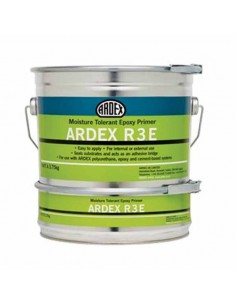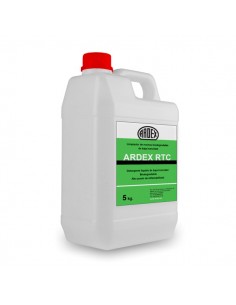ARDEX R70PE is a medium-strength polyurethane mortar for the application of polyurethane resin-based floor coverings, which combines outstanding wear properties with high chemical resistance as well as pleasant decorative aspects. It is suitable for aggressive areas where a seamless finish is required and maximum cleanliness is essential. In particular, factories, production plants and high traffic areas are just some of the environments that can benefit from the highly chemical resistant system.
- High performance.
- Polyurethane resin flooring system.
- Four components in pre-metered packages.
- 2 to 5 mm layers.
- Wear resistant - extremely durable.
- Abrasion resistant with low maintenance costs.
- Resists a wide range of chemical products and liquids.
- Seamless - allows easy cleaning to maintain a high level of hygiene.
- FeRFA (resin association) classification: Type 7.
Substrate preparation:
The substrate must be hard, solid and free of dust or other loose particles such as paint, lime residues, mortar, plaster, adhesive residues, etc., which may impair adhesion to the substrate.
Before mechanical preparation, varnish residues, waxes, grease, oils and similar contaminants must be removed. Contaminated concrete surfaces must be treated mechanically, either by sanding, shot blasting or sandblasting, followed by vacuuming.
Any joints or cracks in the concrete substrate where differential movement is expected, e.g. expansion joints, should be brought up to the finished surface and properly sealed.
Thick slabs of new concrete should be allowed to harden for at least 14 days.
To ensure maximum adhesion, joints should be made around the perimeter of the substrate, which are 8 mm deep and 8 mm wide. These should be inserted approximately 10 cm away from the walls and run parallel to the walls and the adjacent door opening and wall skirtings, etc. including any finishing corners and free opening joints. Joints must have clean, square edges and the product must be pushed all the way into the groove and form a perimeter anchor. Joints should surround areas not exceeding approx. 20 m2.
Steel plates:
The steel surface should be clean, solid and adequately supported to prevent bending. Plate thicknesses of less than 4 mm are not recommended. Surfaces should be shot blasted to Sa2½ and primed with ARDEX epoxy resin.
Priming:
All substrates suitable to receive ARDEX R70P must first be primed with ARDEX epoxy resin (ARDEX R3E, ARDEX DPM 1C). Depending on the condition and porosity of the substrate, one or more coats may be required.
No surface sandblasting is required.
Mixing process:
First mix parts A and B of the ARDEX R70P components for 1 minute, using a suitable mixer inside a suitable sized container. Mix the pigment.
Then, the contents of part C, powder component, should be introduced into the resin mixture and mixed together for a further 2 minutes to create a homogeneous mass. One or more packets can be mixed at the same time.
Application:
For floor covering applications, the mixed material should be placed without delay on the prepared and primed surface using a spreader skid and/or trowel to smooth it. As soon as the product has been spread and depending on the progress of the work, the surface should be gently rolled with a spiked roller to achieve a flat surface appearance. The spiked roller should not be rolled over a second time. During the application process and initial curing time, the working area should be protected to ensure that none of the airborne residues can contaminate the wet resin, as these would cause unwanted staining of the cured and treated surface.
All expansion joints in the substrate must be raised to the plaster and sealed accordingly.
Construction joints and cracks that are not subject to movement can be covered, but if the substrate should nevertheless move, these defects will be reflected through the plaster. Insulation joints should be made in areas where strong thermal shocks are expected, e.g. around cookers and freezers.
Limitations:
ARDEX R70P should only be applied at temperatures above +10°C and below +30°C and where the atmospheric relative humidity (RH) is less than 90 % or less. Soils must have a RH of 75 % or less. Soils with residual moisture must be treated with ARDEX DPM membrane.
The substrate must have a tensile strength of at least 1.5 N/mm2. ARDEX R70P and DPM Primer can be applied to substrates of lower strength, but the long-term performance may be affected. As soon as the mixed material has exceeded its shelf life in the container, the viscosity and characteristics of the product will change and any unused product should be discontinued at that time.
Tool cleaning:
ARDEX R70P can be removed from tools and equipment by applying ARDEX TOOL CLEANER (RTC cleaner) immediately after use. Any hardened material should be removed mechanically.
Chemical resistance:
ARDEX R70P is resistant to a wide range of liquids and chemicals. For more specific information, please consult the Ardex technical department.
Storage:
Storage should take place in a dry place between +5°C and +30°C. Protection against frost and direct sunlight is required. The shelf life is 6 months, in the original unopened containers.
Precautionary measures:
During mixing and application, the following precautionary measures must be observed: ensure adequate ventilation and avoid contact of the material with eyes, nostrils, mouth and unprotected skin. Avoid contact with hands by wearing protective gloves and, if necessary, applying a suitable protective cream.






